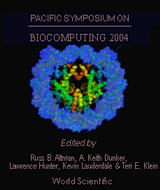Transcriptome and genome conservation of alternative splicing events in humans and mice
Sugnet CW, Kent WJ, Ares M Jr, Haussler D
Center for Biomolecular Science and Engineering, University of California, Santa Cruz, CA 95064, USA.
Pac Symp Biocomput. 2004;:66-77.

Abstract
Combining mRNA and EST data in splicing graphs with whole genome alignments, we discover alternative splicing events that are conserved in both human and mouse transcriptomes. 1,964 of 19,156 (10%) loci examined contain one or more such alternative splicing events, with 2,698 total events. These events represent a lower bound on the amount of alternative splicing in the human genome. Also, as these alternative splicing events are conserved between the human and mouse transcriptomes they should be enriched for functionally significant alternative splicing events, free from much of the noise found in the EST libraries. Further classification of these alternative splicing events reveals that 1,037 (38.4%) are due to exon skipping, 497 (18.4%) are due to alternative 3' splice sites, 214 (7.9%) are due to alternative 5' splice sites, 75 (2.8%) are due to intron retention and the other 875 (32.4%) are due to other, more complicated, alternative splicing events. In addition, genomic sequences nearby these alternative splicing events display increased sequence conservation. Both the alternatively spliced exons and the proximal intron show increased levels of genomic conservation relative to constitutively spliced exons. For exon skipping events both intron regions flanking the exon are conserved while for alternative 5' and 3' splicing events the conservation is greater near the alternative splice site.
[Full-Text PDF] [PSB Home Page]